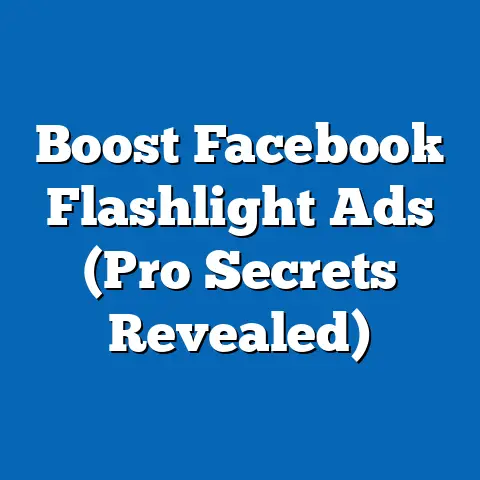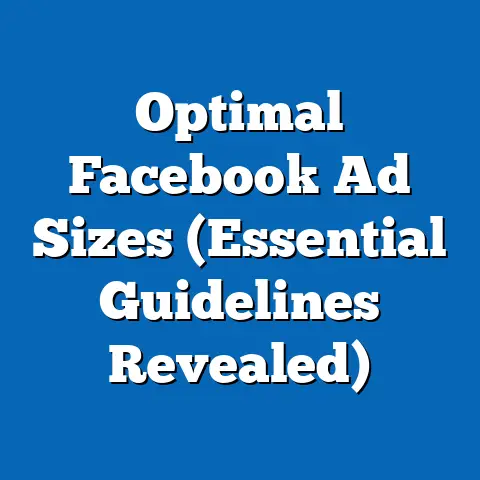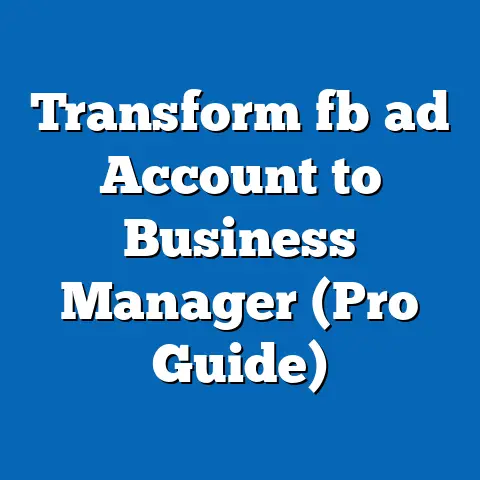Maximize ROI with 4:5 Ratio Facebook Ads (Proven Strategies)
In the ever-evolving landscape of digital marketing, businesses are constantly seeking innovative ways to maximize return on investment (ROI) while capturing the attention of their target audience. One proven solution that has emerged as a game-changer on platforms like Facebook is the strategic use of the 4:5 aspect ratio for ads—a vertical format tailored for mobile-first audiences. This format, often referred to as the “portrait” ratio, optimizes screen real estate on smartphones, where the majority of social media users engage with content, offering a visually immersive experience that drives higher engagement and conversions.
The 4:5 ratio, with its dimensions of 1080×1350 pixels, is specifically designed to align with how users naturally hold their devices, filling the screen without requiring rotation or excessive scrolling. Its defining characteristics include a focus on vertical storytelling, enhanced visual impact, and compatibility with mobile-centric platforms like Facebook and Instagram Stories. As mobile usage continues to dominate digital interactions—Statista reports that over 90% of internet users access social media via mobile devices in 2023—this format has become a critical tool for advertisers aiming to cut through the noise.
Historically, the shift to vertical formats like 4:5 reflects broader societal trends toward mobile-first consumption, a phenomenon rooted in the rapid adoption of smartphones since the late 2000s. This transition has reshaped how brands communicate, pushing them to adapt to shorter attention spans and on-the-go lifestyles. The societal implications are profound, as the 4:5 ratio not only influences marketing strategies but also reflects changing user behaviors, expectations for instant gratification, and the prioritization of visual content over text-heavy ads. This article explores the proven strategies for leveraging the 4:5 ratio on Facebook ads, delving into its historical context, key tactics, and broader impacts on digital advertising and consumer culture.
Historical Context: The Rise of Mobile-First Advertising
The emergence of the 4:5 ratio as a dominant ad format is inseparable from the history of mobile technology and social media. In the early 2000s, digital advertising was primarily designed for desktop screens, with horizontal formats like 16:9 or banner ads dominating the landscape. However, the launch of the iPhone in 2007 marked a turning point, ushering in an era of widespread smartphone adoption that fundamentally altered how content was consumed.
By the mid-2010s, platforms like Snapchat and Instagram began prioritizing vertical video and image formats to cater to mobile users who rarely rotated their devices. Facebook, recognizing this shift, introduced support for vertical ads in 2016, with the 4:5 ratio gaining prominence as an ideal balance between visibility and creative flexibility. According to a 2019 study by Facebook IQ, vertical ads in the 4:5 format saw a 25% higher engagement rate compared to traditional square or horizontal formats, underscoring their effectiveness in capturing attention on mobile feeds.
This historical pivot was driven by broader societal changes, including the rise of Millennials and Gen Z as key consumer demographics. These generations, often described as “digital natives,” grew up with smartphones as primary tools for communication and entertainment, shaping their preference for quick, visually engaging content. The 4:5 ratio, therefore, is not just a technical specification but a response to cultural shifts toward immediacy, accessibility, and mobile-first lifestyles—a trend that continues to influence advertising strategies today.
Defining Characteristics of 4:5 Ratio Ads
The 4:5 ratio stands out in the crowded field of digital ad formats due to its unique characteristics that cater specifically to mobile users. First and foremost, it maximizes screen real estate on vertical smartphone displays, reducing wasted space and ensuring that the ad occupies the viewer’s full field of vision. This immersive quality is critical in an era where users scroll through feeds at lightning speed, often deciding within seconds whether to engage with content.
Additionally, the 4:5 format supports vertical storytelling, allowing brands to craft narratives that flow naturally from top to bottom. This is particularly effective for video ads, where seamless transitions and dynamic visuals can maintain viewer interest. Unlike square (1:1) or horizontal (16:9) formats, which may appear cropped or require awkward zooming on mobile devices, 4:5 aligns with user behavior, offering a frictionless experience.
Finally, the format is versatile, accommodating a range of creative elements such as bold headlines, striking imagery, and clear calls-to-action (CTAs) without overcrowding the frame. Facebook’s own design guidelines recommend keeping critical text and logos within the central 80% of the frame to avoid truncation, ensuring that the 4:5 ratio delivers both aesthetic appeal and functional clarity. These characteristics collectively make it a powerful tool for advertisers seeking to optimize ROI in a mobile-dominated digital ecosystem.
Societal Implications: Changing Consumer Behavior and Brand Communication
The widespread adoption of the 4:5 ratio in Facebook advertising reflects and reinforces significant societal trends. At its core, this format caters to the growing dominance of mobile devices as primary touchpoints for consumer-brand interactions. A 2022 report by eMarketer found that mobile ad spending in the U.S. alone surpassed $100 billion, driven by the fact that over 70% of social media time is spent on smartphones. The 4:5 ratio, by prioritizing mobile optimization, enables brands to meet consumers where they are, aligning with on-the-go lifestyles and fragmented attention spans.
Beyond mere convenience, the shift to vertical formats like 4:5 mirrors deeper cultural changes in how information is processed. Younger generations, particularly Gen Z, exhibit a preference for snackable, visually driven content over traditional long-form media—a trend evident in the popularity of platforms like TikTok and Instagram Reels. The 4:5 ratio supports this by enabling quick, impactful messaging that resonates with users accustomed to rapid content consumption.
For brands, this has profound implications for communication strategies. The format demands a rethinking of creative design, pushing advertisers to prioritize visual hierarchy and emotional resonance over text-heavy pitches. Moreover, it underscores the democratization of advertising, as small businesses and individual creators can leverage the same mobile-optimized tools as large corporations, leveling the playing field in digital spaces. However, this also raises questions about content saturation and the potential for ad fatigue, as users are bombarded with increasingly similar vertical ads.
Proven Strategies for Maximizing ROI with 4:5 Ratio Facebook Ads
To fully harness the potential of the 4:5 ratio, advertisers must adopt data-driven strategies that align with both platform capabilities and audience preferences. Below are proven tactics, supported by research and industry insights, to optimize ROI on Facebook ads using this format.
1. Prioritize Mobile-First Design Principles
Given that the 4:5 ratio is inherently mobile-centric, ads must be designed with small screens in mind. This means using high-contrast visuals, legible fonts, and minimal text to ensure clarity even on lower-resolution displays. A 2021 study by Socialbakers revealed that ads with less than 20% text coverage in the image area achieved 30% higher click-through rates (CTR), as they avoided triggering Facebook’s text overlay restrictions.
Additionally, brands should test their ads on various devices to ensure compatibility and visual appeal. Incorporating motion—such as short video clips or animations—can further enhance engagement, as vertical videos in the 4:5 format are 90% more likely to be watched to completion compared to horizontal ones, per a Wistia report from 2020.
2. Leverage Vertical Storytelling for Emotional Impact
The 4:5 ratio’s vertical orientation offers a unique canvas for storytelling that feels personal and direct. Brands should structure their ads to guide viewers through a narrative arc, starting with an attention-grabbing visual at the top, followed by key messaging in the middle, and a strong CTA at the bottom. For example, a fitness brand might begin with a striking image of a workout, transition to text highlighting a product benefit, and end with a “Shop Now” button.
This approach taps into the psychological principle of primacy and recency, where viewers are most likely to remember the first and last elements they see. Case studies from brands like Nike and Adidas, which frequently use 4:5 ads on Facebook, show that storytelling-focused campaigns can boost brand recall by up to 40%, according to Nielsen data.
3. Optimize for Speed and Attention
In a fast-scrolling environment, 4:5 ads must capture attention within the first three seconds. This can be achieved by using bold colors, dynamic imagery, or unexpected visuals at the top of the frame. Facebook’s internal research indicates that ads with high visual impact in the initial frame achieve a 20% higher view-through rate.
Moreover, advertisers should keep video ads concise—ideally under 15 seconds for maximum retention. A 2022 report by Hootsuite found that short-form vertical videos on social media platforms had a 35% higher completion rate compared to longer formats, reinforcing the importance of brevity in the 4:5 context.
4. Incorporate Clear and Compelling CTAs
A well-placed CTA is critical for converting engagement into action, and the 4:5 ratio’s vertical layout offers a natural endpoint for guiding user behavior. Positioning the CTA at the bottom of the ad ensures it remains visible even as users scroll, while using action-oriented language like “Learn More” or “Get Started” can drive clicks. According to WordStream, ads with explicit CTAs see a 25% higher conversion rate compared to those without.
Interactive elements, such as polls or swipe-up features (where applicable), can also enhance user interaction within the 4:5 frame. These tactics create a sense of immediacy, encouraging users to act without leaving the platform—a key factor in maximizing ROI.
5. Test and Iterate with A/B Testing
No single ad design guarantees success, which is why continuous testing is essential. Advertisers should run A/B tests comparing different 4:5 ad variations—such as imagery, copy, or CTA placement—to identify what resonates most with their audience. Facebook’s Ads Manager provides robust tools for split testing, allowing brands to measure metrics like CTR, cost-per-click (CPC), and conversion rates.
For instance, a 2023 case study by HubSpot demonstrated that a retail brand reduced its CPC by 18% after testing multiple 4:5 ad creatives and refining based on performance data. This iterative approach ensures that ad spend is allocated to the most effective content, directly boosting ROI.
6. Target and Personalize for Relevance
The 4:5 ratio’s effectiveness is amplified when paired with precise audience targeting. Facebook’s advanced targeting options—such as demographics, interests, and lookalike audiences—allow advertisers to deliver tailored 4:5 ads to the right users at the right time. Personalization can be further enhanced by using dynamic ads that automatically adjust content based on user behavior, such as past purchases or browsing history.
A 2022 study by Accenture found that 91% of consumers are more likely to engage with brands that offer personalized experiences, highlighting the importance of relevance in ad design. By combining the visual power of 4:5 with data-driven targeting, brands can create highly effective campaigns that resonate on a personal level.
Comparative Analysis: 4:5 Ratio vs. Other Ad Formats
While the 4:5 ratio offers distinct advantages, it’s important to compare its performance against other common ad formats on Facebook to understand its unique value. The square 1:1 ratio, for instance, is versatile and works well across both mobile and desktop, but it often fails to fully utilize vertical screen space, resulting in lower engagement on smartphones. A 2020 analysis by Buffer found that 4:5 ads outperformed 1:1 ads by 15% in terms of CTR on mobile feeds.
Similarly, the traditional 16:9 horizontal format, while effective for cinematic storytelling, often appears cropped or requires users to rotate their devices—an action most are unwilling to take. This friction reduces visibility, with studies showing a 30% drop in view time for horizontal ads on mobile compared to vertical formats. However, 16:9 remains relevant for desktop campaigns or platforms like YouTube, where horizontal viewing is the norm.
The 4:5 ratio’s primary strength lies in its mobile optimization, but it’s not without limitations. On desktop, it may appear less impactful due to sidebars or empty space, and its vertical focus can constrain broader landscape-style visuals. Advertisers must weigh these trade-offs, often using a mix of formats depending on campaign goals and audience behavior.
Technological and Economic Factors Driving 4:5 Adoption
The rise of the 4:5 ratio is closely tied to technological advancements in mobile hardware and software. Modern smartphones boast high-resolution displays and faster processing speeds, enabling seamless rendering of vertical video and imagery. Social media platforms have also adapted, with Facebook and Instagram prioritizing vertical content in their algorithms to enhance user experience—a move that incentivizes advertisers to adopt the 4:5 format.
Economically, the shift to mobile-first advertising reflects the growing importance of cost-efficiency in digital marketing. Vertical ads often achieve lower CPC and cost-per-acquisition (CPA) due to higher engagement rates, making them an attractive option for businesses with limited budgets. A 2023 report by eMarketer noted that mobile ad formats like 4:5 delivered a 20% better ROI compared to desktop-centric formats, driven by their alignment with user behavior.
However, economic disparities in device access must be acknowledged. While smartphone penetration is near-universal in developed markets, some regions still rely on older devices or desktop systems, potentially limiting the reach of 4:5 campaigns. Advertisers must balance these factors, ensuring campaigns are adaptable across diverse technological landscapes.
Social and Cultural Influences on 4:5 Ad Effectiveness
Socially, the 4:5 ratio resonates with a culture increasingly defined by mobile connectivity and visual communication. The format aligns with the rise of influencer marketing, where authentic, vertical content—often shot directly on smartphones—feels more relatable to audiences. This cultural shift toward user-generated aesthetics has pushed brands to adopt a less polished, more organic style in their 4:5 ads, fostering trust and engagement.
Culturally, the format also reflects generational differences in media consumption. While Millennials and Gen Z grav ascendant Gen X and Baby Boomers, who came of age before the smartphone era, may exhibit varied comfort levels with mobile-first content. However, even older demographics are adapting, with a 2022 Pew Research Center survey showing that 61% of adults over 65 now own smartphones. The 4:5 ratio’s intuitive design helps bridge this gap, offering a straightforward viewing experience that transcends generational tech divides.
Yet, cultural nuances within generations must be considered. For instance, visual preferences can vary by region—vibrant colors may resonate more in some cultures, while minimalism appeals in others. Advertisers using 4:5 ads must tailor content to reflect these diverse sensibilities, avoiding a one-size-fits-all approach.
Implications for Society, Culture, and the Workplace
The proliferation of 4:5 ratio ads has far-reaching implications beyond marketing. Socially, it reinforces the centrality of mobile devices in daily life, potentially deepening digital dependency while also enhancing accessibility to information and products. Culturally, it contributes to the prioritization of visual over textual communication, which may influence literacy trends and attention spans over time.
In the workplace, the 4:5 format has reshaped roles within marketing and creative industries. Designers and content creators must now prioritize mobile-first skills, while data analysts play a larger role in optimizing ad performance through tools like Facebook Ads Manager. This shift also impacts hiring trends, with a 2023 LinkedIn report noting a 35% increase in demand for digital marketing specialists familiar with vertical formats.
For businesses, the format offers opportunities to connect with diverse audiences but also challenges in maintaining originality amidst a flood of vertical content. The risk of ad fatigue looms large, as users may grow desensitized to repetitive 4:5 designs, pushing companies to innovate continuously.
Forward-Looking Insights: The Future of 4:5 Ads and Beyond
Looking ahead, the 4:5 ratio is likely to remain a cornerstone of mobile advertising, driven by ongoing trends in smartphone usage and platform algorithms. Emerging technologies, such as augmented reality (AR) and interactive vertical ads, could further enhance its capabilities, offering immersive experiences within the same frame. Facebook’s investment in AR tools for ads, for instance, suggests a future where 4:5 campaigns blend virtual and real-world elements.
However, uncertainties persist. Shifts in user behavior—such as potential backlash against digital overload—could challenge the format’s dominance. Privacy concerns and evolving regulations, like the EU’s General Data Protection Regulation (GDPR), may also limit targeting precision, a key driver of 4:5 ad success. Additionally, the rise of new platforms or formats could disrupt current norms, requiring advertisers to remain agile.
Ultimately, the 4:5 ratio represents both a response to and a driver of societal change, encapsulating the mobile-first era’s opportunities and complexities. As brands refine their strategies, balancing creativity with data-driven optimization will be key to sustaining ROI. While the future is uncertain, the principles underlying 4:5 ads—user-centric design, visual impact, and adaptability—will likely endure as guiding lights in the ever-shifting digital landscape.






